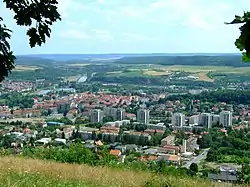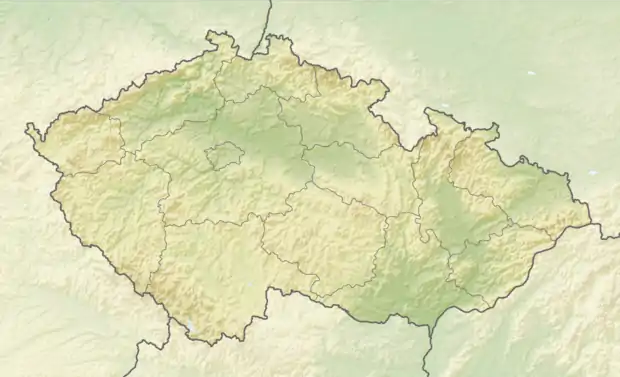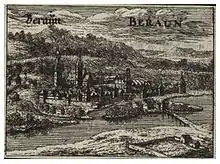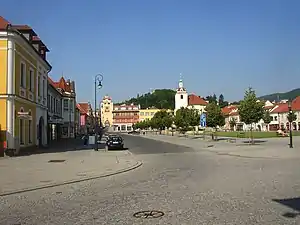Beroun
Beroun (Czech pronunciation: [ˈbɛroun]; German: Beraun) is a town in the Central Bohemian Region of the Czech Republic and an administrative centre of Beroun District. It has a population of about 20,000. Beroun has strong connection with Králův Dvůr, former part of Beroun.
Beroun | |
|---|---|
Town | |
 View of Beroun | |
 Flag  Coat of arms | |
 Beroun Location in the Czech Republic | |
| Coordinates: 49°57′51″N 14°4′26″E | |
| Country | |
| Region | Central Bohemian |
| District | Beroun |
| First mentioned | 1265 |
| Government | |
| • Mayor | Soňa Chalupová |
| Area | |
| • Total | 31.31 km2 (12.09 sq mi) |
| Elevation | 235 m (771 ft) |
| Population (2020-01-01[1]) | |
| • Total | 19,641 |
| • Density | 630/km2 (1,600/sq mi) |
| Time zone | UTC+1 (CET) |
| • Summer (DST) | UTC+2 (CEST) |
| Postal code | 266 01 |
| Website | www |
Geography
The town is located about 30 kilometres (19 mi) southwest of Prague at the confluence of Berounka and Litavka rivers. The town is a part of the Prague metropolitan area.
The surrounding landscape is hilly. Beroun itself is situated in a deep valley, which has been a limitation on building development. The highest point is the Děd peak, 493 meters above sea level. The lowest point is the Berounka river, 212 meters above sea level. Neighboring hills of Brdy and Křivoklátská vrchovina are protected landscape areas, popular for tourist.
History
A settlement na Brodě ("by the ford") was first mentioned in a 1088 deed. As a royal Bohemian town, it received its present name in the 13th century. Its name may be derived from (Welsch-)Bern, the archaic German name of Verona in Italy, but alternatively might be a form of the ancient Slavic theonym Perun. Already in the High Middle Ages, under the rule of King Wenceslaus II, it was a fortified town. Many citizens were German merchants, settling here in the course of the Ostsiedlung.
Beroun officially obtained town privileges from Emperor Charles IV, who was especially attached to the place, calling it "Verona mea." Under his patronage the town rapidly prospered.[2] In 1421 Hussite forces under the command of Jan Žižka stormed the town, and though it was retaken and devastated after the Battle of Lipany, it has remained a mainly Czech settled town since then.

Under the rule of the House of Habsburg from 1526, the town's estates were seized. During the Thirty Years' War it was sacked in turn by the Imperial army, Saxon forces, and Swedish forces. In the First Silesian War the same fate befell it at the hands of French and Bavarian troops.[2]
In the early 18th century the Chapel of Virgin Mary of Sorrows, now a cultural heritage site, was built in the town.
In the 18th century, Beroun became a garrison town and did not prosper again until the 1860s, with the opening of limestone quarries and iron ore mines. Beside several ironworks, Beroun became the site of textile manufacturing, and the population increased.

Beroun was significantly transformed during communist rule. Heavy industry was expanded, and central government policy set quotas for new flats. As Beroun is situated between two rivers in a deep valley without suitable building plots, quotas were met by demolishing historical medieval buildings and erecting prefabricated high-rise buildings. The town look was changed again in the 1980s when the D5 highway was opened, running on the bridge above the town.
Králův Dvůr town, together with multiple villages, was joined to Beroun, and then left it in 1990.
Since the fall of communism, the town has been revitalised. Medieval buildings have been reconstructed, and town walls have been conserved. Heavy industry left the town, significantly raising the quality of living. In the 21st century, Beroun has become a popular place to live because of its proximity to Prague and its excellent travel connections.
Transport
Beroun is connected via D5 motorway with Prague and German Bundesautobahn 6 to Nuremberg, part of the European route E50. 3rd Railway Corridor leads through the town.
Notable people
- Otokar Feistmantel (1848–1891), geologist and paleontologist
- Václav Talich (1883–1961), conductor, died in Beroun
References
- "Population of Municipalities – 1 January 2020". Czech Statistical Office. 2020-04-30.
-
 One or more of the preceding sentences incorporates text from a publication now in the public domain: Chisholm, Hugh, ed. (1911). "Beraun". Encyclopædia Britannica. 3 (11th ed.). Cambridge University Press. p. 764.
One or more of the preceding sentences incorporates text from a publication now in the public domain: Chisholm, Hugh, ed. (1911). "Beraun". Encyclopædia Britannica. 3 (11th ed.). Cambridge University Press. p. 764. - "Partnerská města". mesto-beroun.cz (in Czech). Město Beroun. Retrieved 2020-08-06.